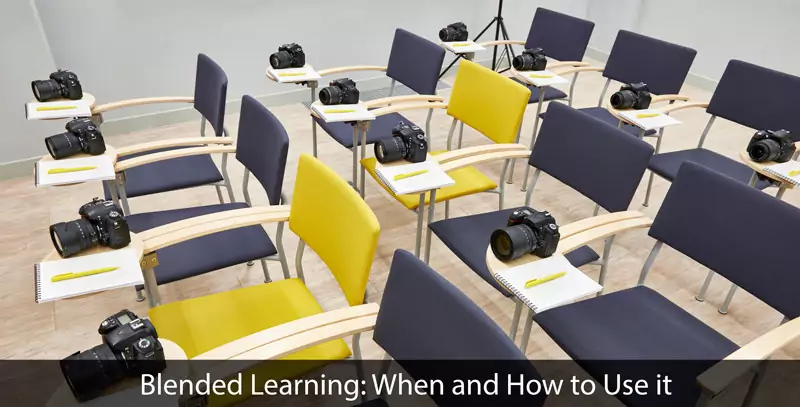Blended Learning: When and How to Use it

In today’s increasingly digital world, it’s all too easy to just assume that eLearning is always the way to go. But it’s worth remembering that the choice you face isn’t a black-and-white, either/or choice between eLearning and traditional learning. They can be mixed together as well, which is called blended learning. And sometimes that’s the best choice of all. What drives the choice between eLearning, traditional learning, or a mix of both?

Let me start by saying what should not drive the choice, which is fear of eLearning. There are still plenty of holdouts in senior positions at many companies who still regard eLearning as some sort of new-fangled fad that they’d rather not deal with. They’re simply not convinced. Hopefully you’re not facing that kind of resistance, but just be aware that it’s still out there and surprisingly prevalent.
One way to figure out a way forward is to get to know your audience. In fact, you might even ask the people who will ultimately participate in the learning effort how they would like it delivered. If your employees are mostly made up of Millennials, you’re probably going to find they’ll expect or demand an eLearning solution. By all means, give it to them! If a large majority wants a more traditional approach, then go with that. If what you have is real mix of people who want different things, then you might want to consider a blended approach that will probably work for everyone.
And that’s one of the benefits of going with blended learning more often than you might have thought to do. Most of the time you’ll be dealing with a variety of learning styles, and a blended approach is going to more likely to work for more people. Once you start allowing eLearning to complement more traditional learning, the eLearning component is where you can bring in a huge variety of materials – videos, podcasts, enhanced slide presentations, animations, gamification, and more. Everyone ends up getting at least a healthy dose of what they like best.
There are lots of different ways to formulate blended learning programs. Here are a few to consider:
Rotation Blended Learning. In this approach, learners rotate from online to in-person for several cycles throughout the program. For example, everyone may work individually through online material for a time, but then come together in-person to discuss the material and engage in face-to-face activities that extend and deepen content knowledge and its application. The variations on this theme that can be arranged are nearly endless. To design this style, pay particular attention to each online portion and brainstorm what in-person interactions would serve to enhance learning.
Flex Blended Learning. In this model, most of the learning program takes place online, but learners have the option to come together occasionally for in-person activities or can request face-to-face time with instructors on an as-needed basis if they need tutoring support. Rather than a rigid or set rotation, the rotation happens in a more flexible way. As you design this type of program, consider how you’ll insert adequate prompts to find out if users should be requesting specific kinds of in-person instruction support or interactions with their fellow learners.
A La Carte Blended Learning. This is another primarily online model where face-to-face instructional support can be requested, but through virtual means, such a Skype video call or real-time online chat forums. When helpful, learning can wrap up with an in-person workshop or seminar. As before, make sure you design into this type of blended program adequate opportunities to evaluate learner progress so that they can self-identify when they should be requesting support.
Enriched Virtual Blended Learning. This one is primarily face-to-face instruction supplemented by a variety of online options to extend the instructor-led material after its completion. Once again the online extras offer up a whole world of possibilities to build on the in-person instruction. Because of that, as you design this type of program, pay particular attention to which types of online extras will do the best job of enhancing the in-person learning while at the same time keeping the mix of media types fresh and diverse.
If you haven’t given blended learning a try, it’s definitely something you should add to your repertoire of learning efforts. You’ll be surprised at just how well it works and gets the kind of results your company is looking for. Let us know if you need help figuring this out.
Other articles on blended learning: